Importance of Branding as a Marketing Tool and Strategies for Brand Management
VerifiedAdded on 2023/01/12
|16
|5469
|22
AI Summary
This assignment focuses on the importance of branding as a marketing tool and explores different strategies for brand management. It discusses the key components of a successful brand strategy and ways in which brands are managed collaboratively. The assignment also examines techniques for measuring and managing brand value using the example of Marks and Spencer.
Contribute Materials
Your contribution can guide someone’s learning journey. Share your
documents today.
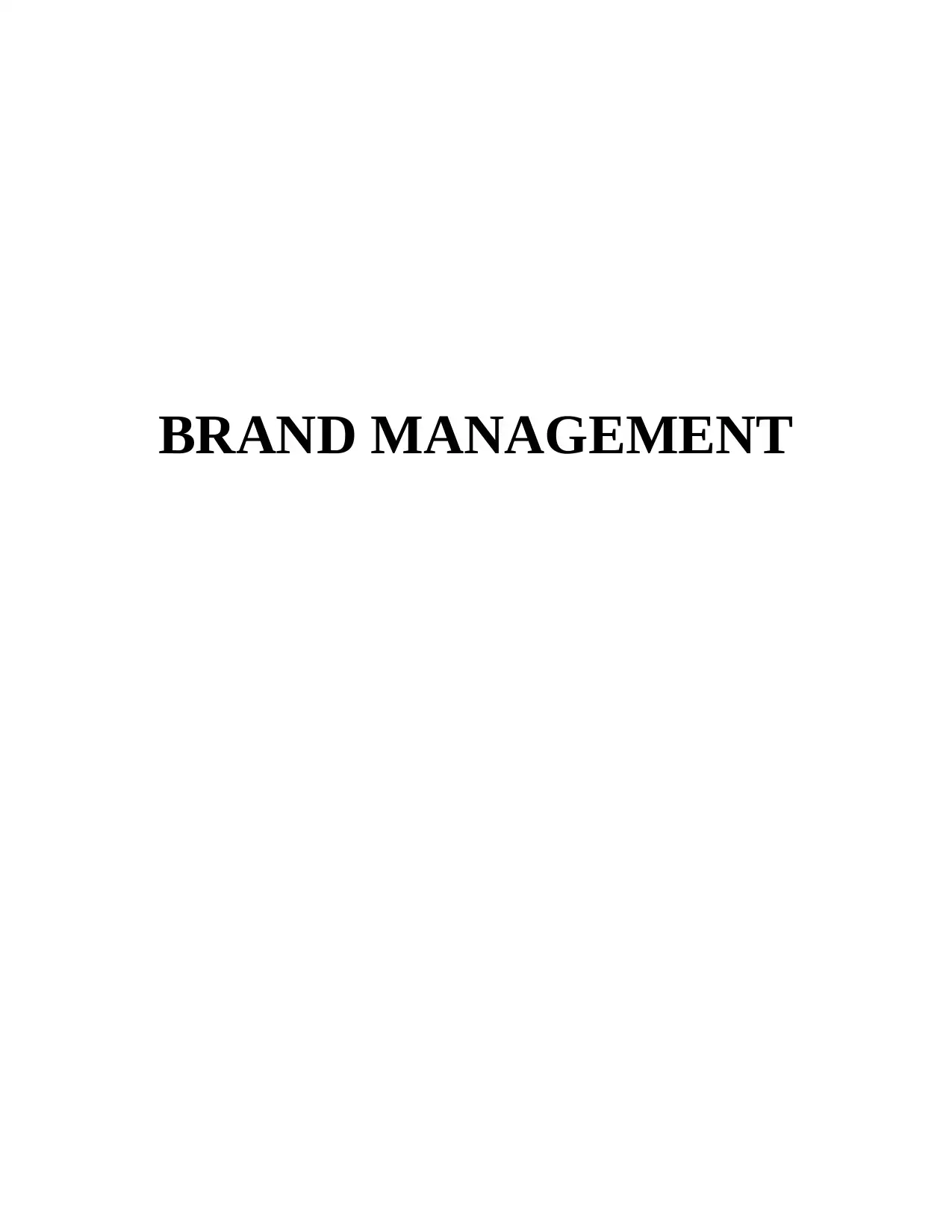
BRAND MANAGEMENT
Secure Best Marks with AI Grader
Need help grading? Try our AI Grader for instant feedback on your assignments.
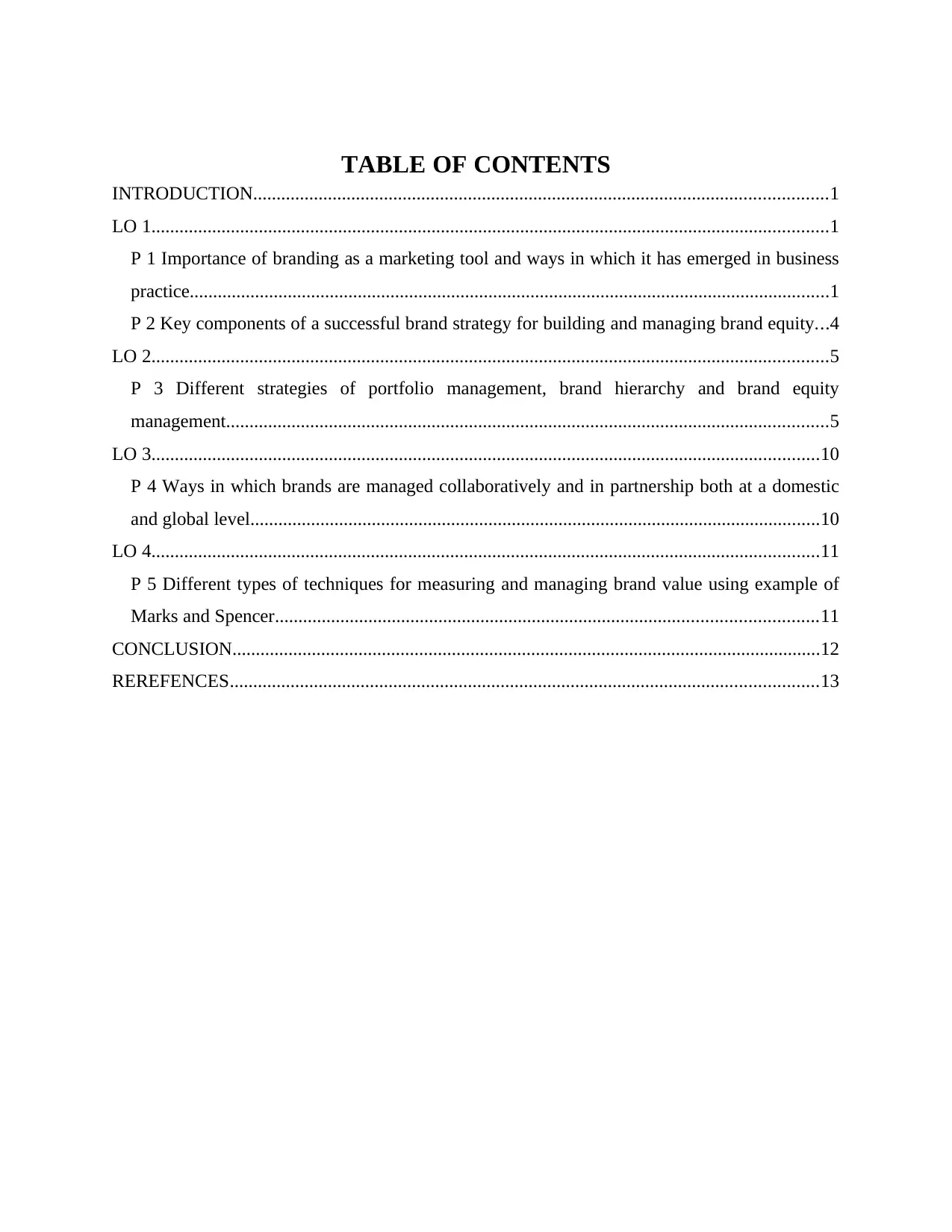
TABLE OF CONTENTS
INTRODUCTION...........................................................................................................................1
LO 1.................................................................................................................................................1
P 1 Importance of branding as a marketing tool and ways in which it has emerged in business
practice.........................................................................................................................................1
P 2 Key components of a successful brand strategy for building and managing brand equity...4
LO 2.................................................................................................................................................5
P 3 Different strategies of portfolio management, brand hierarchy and brand equity
management.................................................................................................................................5
LO 3...............................................................................................................................................10
P 4 Ways in which brands are managed collaboratively and in partnership both at a domestic
and global level..........................................................................................................................10
LO 4...............................................................................................................................................11
P 5 Different types of techniques for measuring and managing brand value using example of
Marks and Spencer....................................................................................................................11
CONCLUSION..............................................................................................................................12
REREFENCES..............................................................................................................................13
INTRODUCTION...........................................................................................................................1
LO 1.................................................................................................................................................1
P 1 Importance of branding as a marketing tool and ways in which it has emerged in business
practice.........................................................................................................................................1
P 2 Key components of a successful brand strategy for building and managing brand equity...4
LO 2.................................................................................................................................................5
P 3 Different strategies of portfolio management, brand hierarchy and brand equity
management.................................................................................................................................5
LO 3...............................................................................................................................................10
P 4 Ways in which brands are managed collaboratively and in partnership both at a domestic
and global level..........................................................................................................................10
LO 4...............................................................................................................................................11
P 5 Different types of techniques for measuring and managing brand value using example of
Marks and Spencer....................................................................................................................11
CONCLUSION..............................................................................................................................12
REREFENCES..............................................................................................................................13
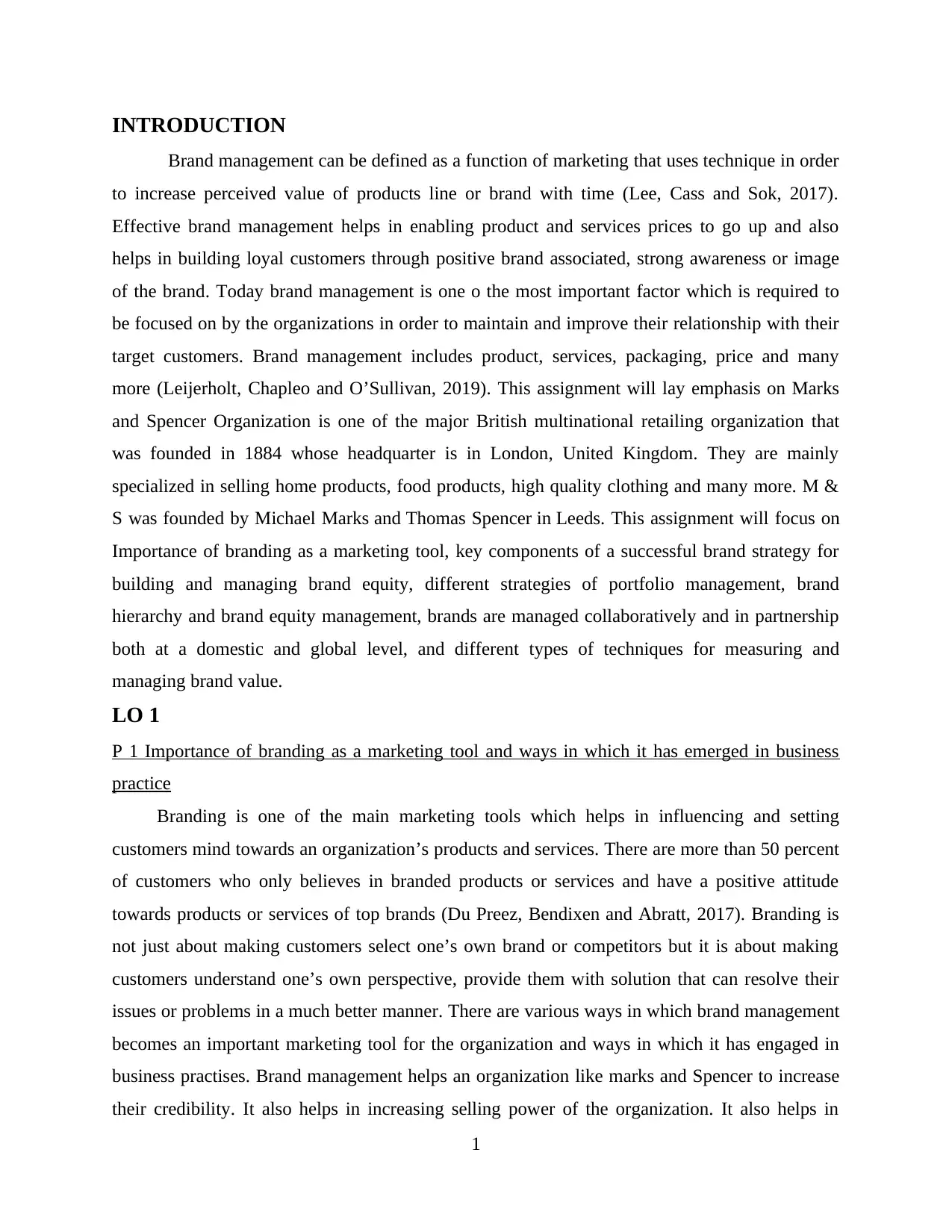
INTRODUCTION
Brand management can be defined as a function of marketing that uses technique in order
to increase perceived value of products line or brand with time (Lee, Cass and Sok, 2017).
Effective brand management helps in enabling product and services prices to go up and also
helps in building loyal customers through positive brand associated, strong awareness or image
of the brand. Today brand management is one o the most important factor which is required to
be focused on by the organizations in order to maintain and improve their relationship with their
target customers. Brand management includes product, services, packaging, price and many
more (Leijerholt, Chapleo and O’Sullivan, 2019). This assignment will lay emphasis on Marks
and Spencer Organization is one of the major British multinational retailing organization that
was founded in 1884 whose headquarter is in London, United Kingdom. They are mainly
specialized in selling home products, food products, high quality clothing and many more. M &
S was founded by Michael Marks and Thomas Spencer in Leeds. This assignment will focus on
Importance of branding as a marketing tool, key components of a successful brand strategy for
building and managing brand equity, different strategies of portfolio management, brand
hierarchy and brand equity management, brands are managed collaboratively and in partnership
both at a domestic and global level, and different types of techniques for measuring and
managing brand value.
LO 1
P 1 Importance of branding as a marketing tool and ways in which it has emerged in business
practice
Branding is one of the main marketing tools which helps in influencing and setting
customers mind towards an organization’s products and services. There are more than 50 percent
of customers who only believes in branded products or services and have a positive attitude
towards products or services of top brands (Du Preez, Bendixen and Abratt, 2017). Branding is
not just about making customers select one’s own brand or competitors but it is about making
customers understand one’s own perspective, provide them with solution that can resolve their
issues or problems in a much better manner. There are various ways in which brand management
becomes an important marketing tool for the organization and ways in which it has engaged in
business practises. Brand management helps an organization like marks and Spencer to increase
their credibility. It also helps in increasing selling power of the organization. It also helps in
1
Brand management can be defined as a function of marketing that uses technique in order
to increase perceived value of products line or brand with time (Lee, Cass and Sok, 2017).
Effective brand management helps in enabling product and services prices to go up and also
helps in building loyal customers through positive brand associated, strong awareness or image
of the brand. Today brand management is one o the most important factor which is required to
be focused on by the organizations in order to maintain and improve their relationship with their
target customers. Brand management includes product, services, packaging, price and many
more (Leijerholt, Chapleo and O’Sullivan, 2019). This assignment will lay emphasis on Marks
and Spencer Organization is one of the major British multinational retailing organization that
was founded in 1884 whose headquarter is in London, United Kingdom. They are mainly
specialized in selling home products, food products, high quality clothing and many more. M &
S was founded by Michael Marks and Thomas Spencer in Leeds. This assignment will focus on
Importance of branding as a marketing tool, key components of a successful brand strategy for
building and managing brand equity, different strategies of portfolio management, brand
hierarchy and brand equity management, brands are managed collaboratively and in partnership
both at a domestic and global level, and different types of techniques for measuring and
managing brand value.
LO 1
P 1 Importance of branding as a marketing tool and ways in which it has emerged in business
practice
Branding is one of the main marketing tools which helps in influencing and setting
customers mind towards an organization’s products and services. There are more than 50 percent
of customers who only believes in branded products or services and have a positive attitude
towards products or services of top brands (Du Preez, Bendixen and Abratt, 2017). Branding is
not just about making customers select one’s own brand or competitors but it is about making
customers understand one’s own perspective, provide them with solution that can resolve their
issues or problems in a much better manner. There are various ways in which brand management
becomes an important marketing tool for the organization and ways in which it has engaged in
business practises. Brand management helps an organization like marks and Spencer to increase
their credibility. It also helps in increasing selling power of the organization. It also helps in
1
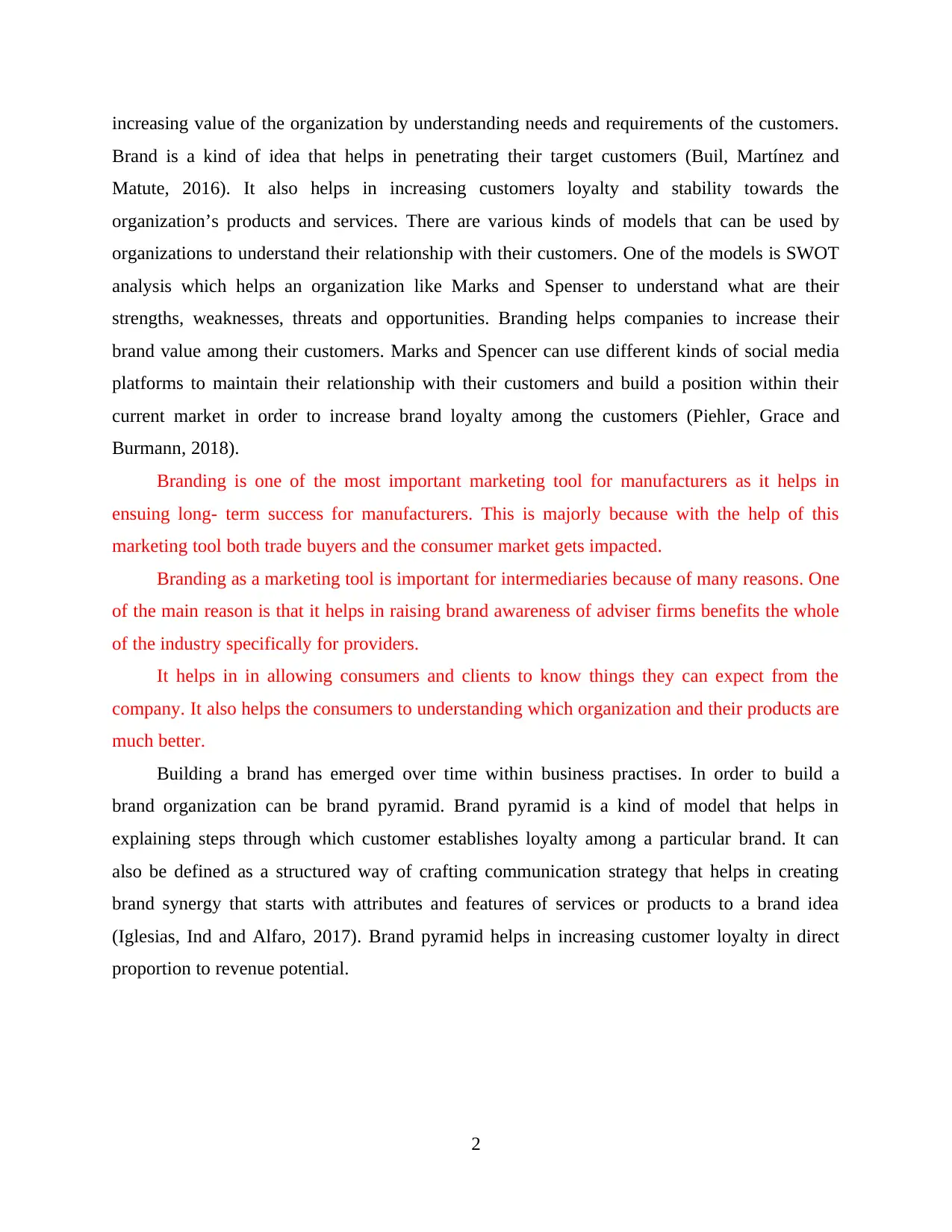
increasing value of the organization by understanding needs and requirements of the customers.
Brand is a kind of idea that helps in penetrating their target customers (Buil, Martínez and
Matute, 2016). It also helps in increasing customers loyalty and stability towards the
organization’s products and services. There are various kinds of models that can be used by
organizations to understand their relationship with their customers. One of the models is SWOT
analysis which helps an organization like Marks and Spenser to understand what are their
strengths, weaknesses, threats and opportunities. Branding helps companies to increase their
brand value among their customers. Marks and Spencer can use different kinds of social media
platforms to maintain their relationship with their customers and build a position within their
current market in order to increase brand loyalty among the customers (Piehler, Grace and
Burmann, 2018).
Branding is one of the most important marketing tool for manufacturers as it helps in
ensuing long- term success for manufacturers. This is majorly because with the help of this
marketing tool both trade buyers and the consumer market gets impacted.
Branding as a marketing tool is important for intermediaries because of many reasons. One
of the main reason is that it helps in raising brand awareness of adviser firms benefits the whole
of the industry specifically for providers.
It helps in in allowing consumers and clients to know things they can expect from the
company. It also helps the consumers to understanding which organization and their products are
much better.
Building a brand has emerged over time within business practises. In order to build a
brand organization can be brand pyramid. Brand pyramid is a kind of model that helps in
explaining steps through which customer establishes loyalty among a particular brand. It can
also be defined as a structured way of crafting communication strategy that helps in creating
brand synergy that starts with attributes and features of services or products to a brand idea
(Iglesias, Ind and Alfaro, 2017). Brand pyramid helps in increasing customer loyalty in direct
proportion to revenue potential.
2
Brand is a kind of idea that helps in penetrating their target customers (Buil, Martínez and
Matute, 2016). It also helps in increasing customers loyalty and stability towards the
organization’s products and services. There are various kinds of models that can be used by
organizations to understand their relationship with their customers. One of the models is SWOT
analysis which helps an organization like Marks and Spenser to understand what are their
strengths, weaknesses, threats and opportunities. Branding helps companies to increase their
brand value among their customers. Marks and Spencer can use different kinds of social media
platforms to maintain their relationship with their customers and build a position within their
current market in order to increase brand loyalty among the customers (Piehler, Grace and
Burmann, 2018).
Branding is one of the most important marketing tool for manufacturers as it helps in
ensuing long- term success for manufacturers. This is majorly because with the help of this
marketing tool both trade buyers and the consumer market gets impacted.
Branding as a marketing tool is important for intermediaries because of many reasons. One
of the main reason is that it helps in raising brand awareness of adviser firms benefits the whole
of the industry specifically for providers.
It helps in in allowing consumers and clients to know things they can expect from the
company. It also helps the consumers to understanding which organization and their products are
much better.
Building a brand has emerged over time within business practises. In order to build a
brand organization can be brand pyramid. Brand pyramid is a kind of model that helps in
explaining steps through which customer establishes loyalty among a particular brand. It can
also be defined as a structured way of crafting communication strategy that helps in creating
brand synergy that starts with attributes and features of services or products to a brand idea
(Iglesias, Ind and Alfaro, 2017). Brand pyramid helps in increasing customer loyalty in direct
proportion to revenue potential.
2
Secure Best Marks with AI Grader
Need help grading? Try our AI Grader for instant feedback on your assignments.
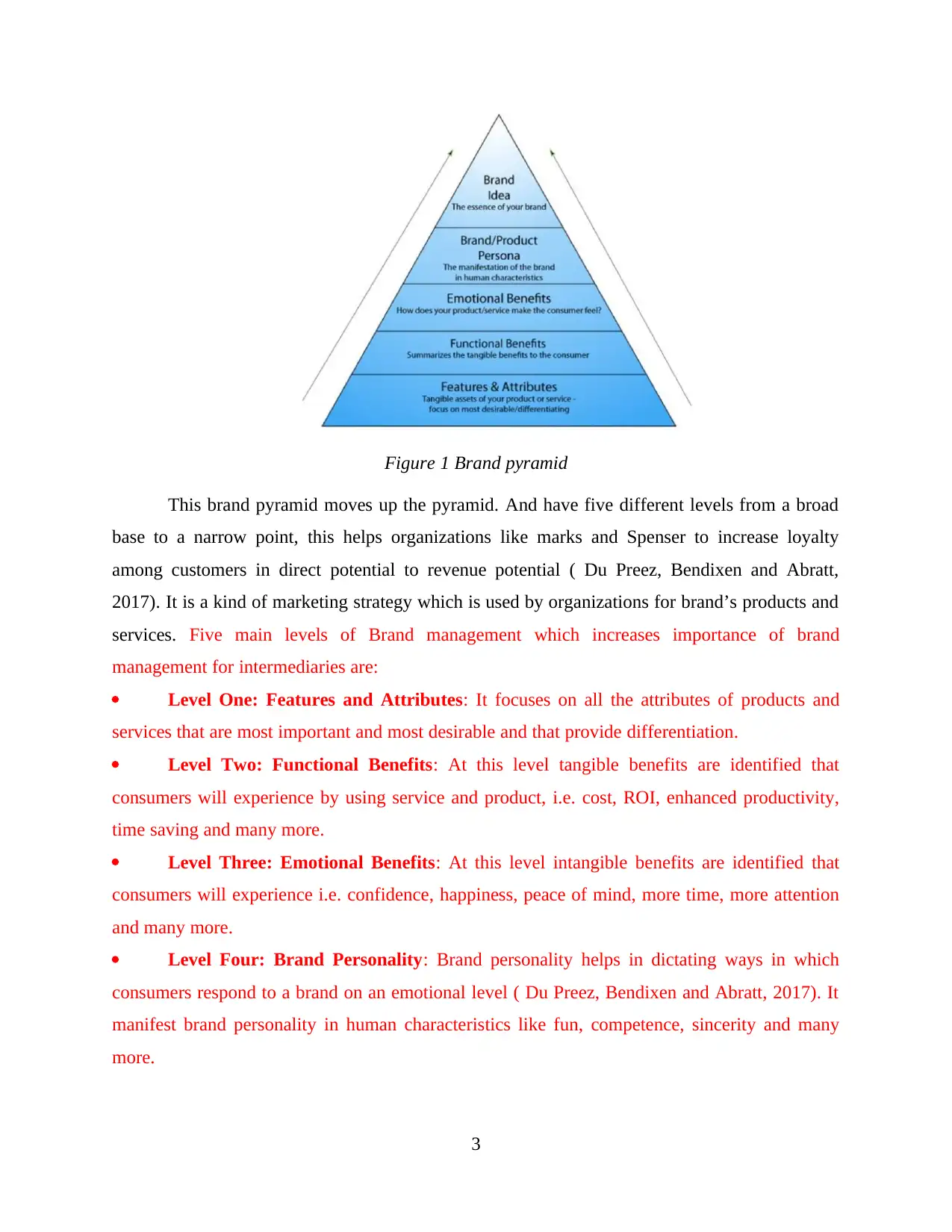
Figure 1 Brand pyramid
This brand pyramid moves up the pyramid. And have five different levels from a broad
base to a narrow point, this helps organizations like marks and Spenser to increase loyalty
among customers in direct potential to revenue potential ( Du Preez, Bendixen and Abratt,
2017). It is a kind of marketing strategy which is used by organizations for brand’s products and
services. Five main levels of Brand management which increases importance of brand
management for intermediaries are:
Level One: Features and Attributes: It focuses on all the attributes of products and
services that are most important and most desirable and that provide differentiation.
Level Two: Functional Benefits: At this level tangible benefits are identified that
consumers will experience by using service and product, i.e. cost, ROI, enhanced productivity,
time saving and many more.
Level Three: Emotional Benefits: At this level intangible benefits are identified that
consumers will experience i.e. confidence, happiness, peace of mind, more time, more attention
and many more.
Level Four: Brand Personality: Brand personality helps in dictating ways in which
consumers respond to a brand on an emotional level ( Du Preez, Bendixen and Abratt, 2017). It
manifest brand personality in human characteristics like fun, competence, sincerity and many
more.
3
This brand pyramid moves up the pyramid. And have five different levels from a broad
base to a narrow point, this helps organizations like marks and Spenser to increase loyalty
among customers in direct potential to revenue potential ( Du Preez, Bendixen and Abratt,
2017). It is a kind of marketing strategy which is used by organizations for brand’s products and
services. Five main levels of Brand management which increases importance of brand
management for intermediaries are:
Level One: Features and Attributes: It focuses on all the attributes of products and
services that are most important and most desirable and that provide differentiation.
Level Two: Functional Benefits: At this level tangible benefits are identified that
consumers will experience by using service and product, i.e. cost, ROI, enhanced productivity,
time saving and many more.
Level Three: Emotional Benefits: At this level intangible benefits are identified that
consumers will experience i.e. confidence, happiness, peace of mind, more time, more attention
and many more.
Level Four: Brand Personality: Brand personality helps in dictating ways in which
consumers respond to a brand on an emotional level ( Du Preez, Bendixen and Abratt, 2017). It
manifest brand personality in human characteristics like fun, competence, sincerity and many
more.
3
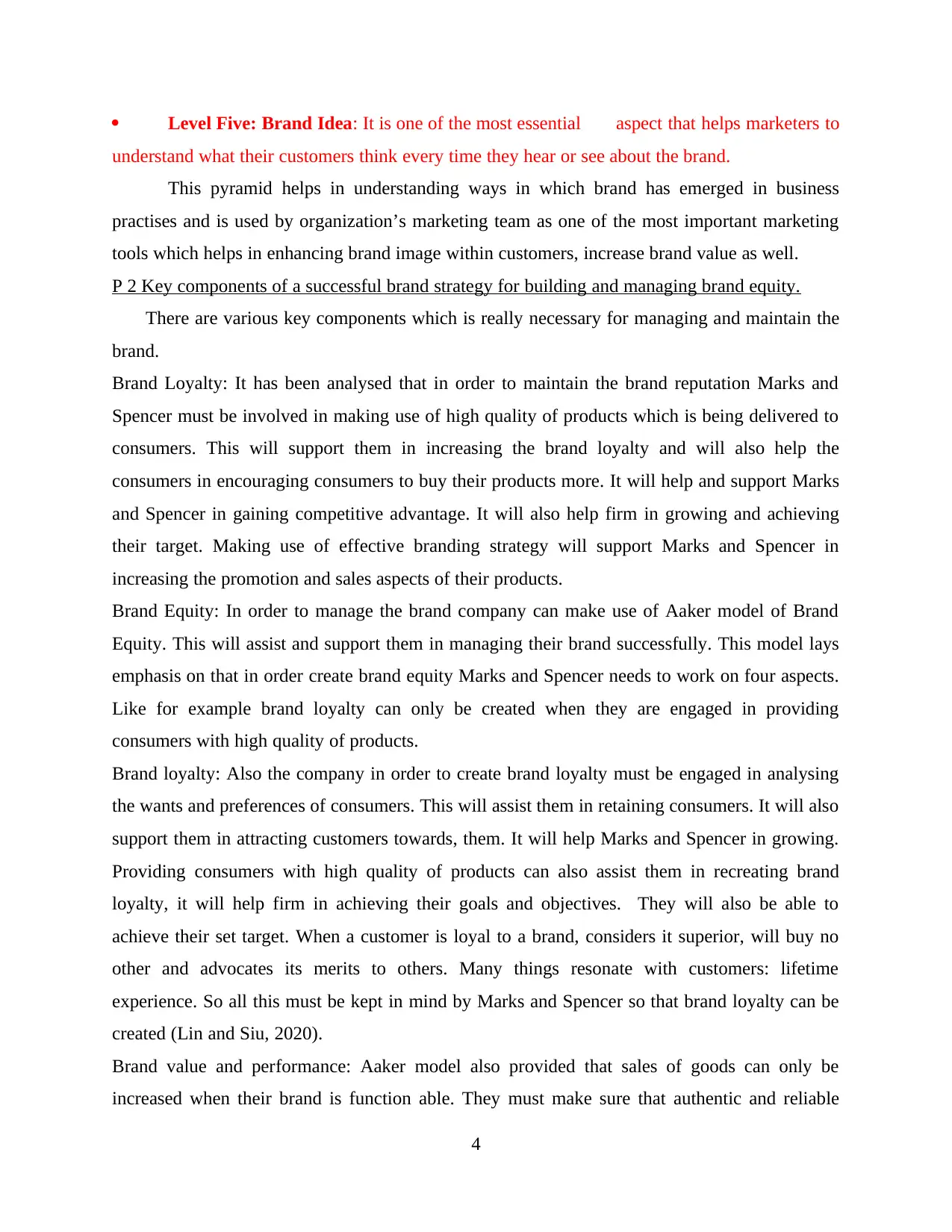
Level Five: Brand Idea: It is one of the most essential aspect that helps marketers to
understand what their customers think every time they hear or see about the brand.
This pyramid helps in understanding ways in which brand has emerged in business
practises and is used by organization’s marketing team as one of the most important marketing
tools which helps in enhancing brand image within customers, increase brand value as well.
P 2 Key components of a successful brand strategy for building and managing brand equity.
There are various key components which is really necessary for managing and maintain the
brand.
Brand Loyalty: It has been analysed that in order to maintain the brand reputation Marks and
Spencer must be involved in making use of high quality of products which is being delivered to
consumers. This will support them in increasing the brand loyalty and will also help the
consumers in encouraging consumers to buy their products more. It will help and support Marks
and Spencer in gaining competitive advantage. It will also help firm in growing and achieving
their target. Making use of effective branding strategy will support Marks and Spencer in
increasing the promotion and sales aspects of their products.
Brand Equity: In order to manage the brand company can make use of Aaker model of Brand
Equity. This will assist and support them in managing their brand successfully. This model lays
emphasis on that in order create brand equity Marks and Spencer needs to work on four aspects.
Like for example brand loyalty can only be created when they are engaged in providing
consumers with high quality of products.
Brand loyalty: Also the company in order to create brand loyalty must be engaged in analysing
the wants and preferences of consumers. This will assist them in retaining consumers. It will also
support them in attracting customers towards, them. It will help Marks and Spencer in growing.
Providing consumers with high quality of products can also assist them in recreating brand
loyalty, it will help firm in achieving their goals and objectives. They will also be able to
achieve their set target. When a customer is loyal to a brand, considers it superior, will buy no
other and advocates its merits to others. Many things resonate with customers: lifetime
experience. So all this must be kept in mind by Marks and Spencer so that brand loyalty can be
created (Lin and Siu, 2020).
Brand value and performance: Aaker model also provided that sales of goods can only be
increased when their brand is function able. They must make sure that authentic and reliable
4
understand what their customers think every time they hear or see about the brand.
This pyramid helps in understanding ways in which brand has emerged in business
practises and is used by organization’s marketing team as one of the most important marketing
tools which helps in enhancing brand image within customers, increase brand value as well.
P 2 Key components of a successful brand strategy for building and managing brand equity.
There are various key components which is really necessary for managing and maintain the
brand.
Brand Loyalty: It has been analysed that in order to maintain the brand reputation Marks and
Spencer must be involved in making use of high quality of products which is being delivered to
consumers. This will support them in increasing the brand loyalty and will also help the
consumers in encouraging consumers to buy their products more. It will help and support Marks
and Spencer in gaining competitive advantage. It will also help firm in growing and achieving
their target. Making use of effective branding strategy will support Marks and Spencer in
increasing the promotion and sales aspects of their products.
Brand Equity: In order to manage the brand company can make use of Aaker model of Brand
Equity. This will assist and support them in managing their brand successfully. This model lays
emphasis on that in order create brand equity Marks and Spencer needs to work on four aspects.
Like for example brand loyalty can only be created when they are engaged in providing
consumers with high quality of products.
Brand loyalty: Also the company in order to create brand loyalty must be engaged in analysing
the wants and preferences of consumers. This will assist them in retaining consumers. It will also
support them in attracting customers towards, them. It will help Marks and Spencer in growing.
Providing consumers with high quality of products can also assist them in recreating brand
loyalty, it will help firm in achieving their goals and objectives. They will also be able to
achieve their set target. When a customer is loyal to a brand, considers it superior, will buy no
other and advocates its merits to others. Many things resonate with customers: lifetime
experience. So all this must be kept in mind by Marks and Spencer so that brand loyalty can be
created (Lin and Siu, 2020).
Brand value and performance: Aaker model also provided that sales of goods can only be
increased when their brand is function able. They must make sure that authentic and reliable
4
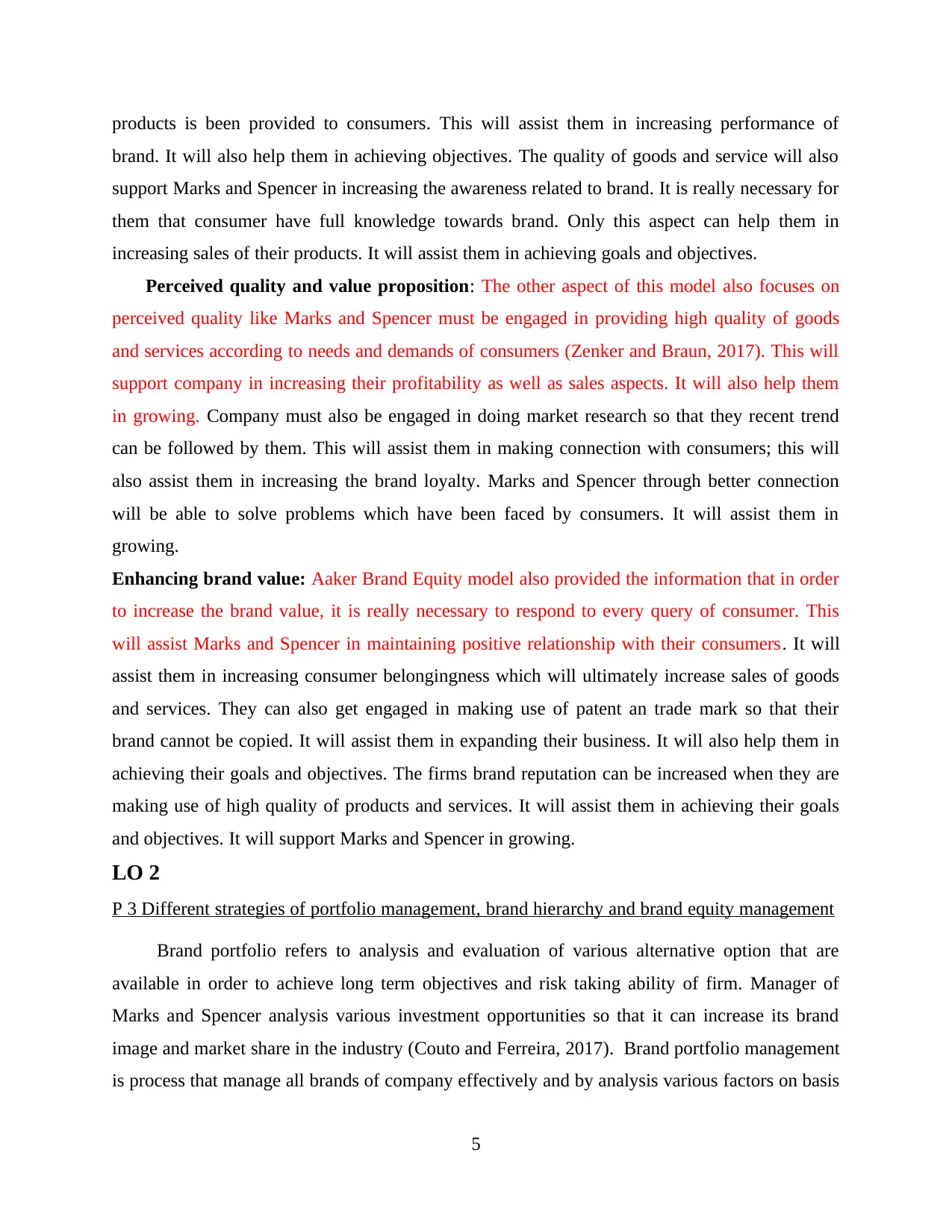
products is been provided to consumers. This will assist them in increasing performance of
brand. It will also help them in achieving objectives. The quality of goods and service will also
support Marks and Spencer in increasing the awareness related to brand. It is really necessary for
them that consumer have full knowledge towards brand. Only this aspect can help them in
increasing sales of their products. It will assist them in achieving goals and objectives.
Perceived quality and value proposition: The other aspect of this model also focuses on
perceived quality like Marks and Spencer must be engaged in providing high quality of goods
and services according to needs and demands of consumers (Zenker and Braun, 2017). This will
support company in increasing their profitability as well as sales aspects. It will also help them
in growing. Company must also be engaged in doing market research so that they recent trend
can be followed by them. This will assist them in making connection with consumers; this will
also assist them in increasing the brand loyalty. Marks and Spencer through better connection
will be able to solve problems which have been faced by consumers. It will assist them in
growing.
Enhancing brand value: Aaker Brand Equity model also provided the information that in order
to increase the brand value, it is really necessary to respond to every query of consumer. This
will assist Marks and Spencer in maintaining positive relationship with their consumers. It will
assist them in increasing consumer belongingness which will ultimately increase sales of goods
and services. They can also get engaged in making use of patent an trade mark so that their
brand cannot be copied. It will assist them in expanding their business. It will also help them in
achieving their goals and objectives. The firms brand reputation can be increased when they are
making use of high quality of products and services. It will assist them in achieving their goals
and objectives. It will support Marks and Spencer in growing.
LO 2
P 3 Different strategies of portfolio management, brand hierarchy and brand equity management
Brand portfolio refers to analysis and evaluation of various alternative option that are
available in order to achieve long term objectives and risk taking ability of firm. Manager of
Marks and Spencer analysis various investment opportunities so that it can increase its brand
image and market share in the industry (Couto and Ferreira, 2017). Brand portfolio management
is process that manage all brands of company effectively and by analysis various factors on basis
5
brand. It will also help them in achieving objectives. The quality of goods and service will also
support Marks and Spencer in increasing the awareness related to brand. It is really necessary for
them that consumer have full knowledge towards brand. Only this aspect can help them in
increasing sales of their products. It will assist them in achieving goals and objectives.
Perceived quality and value proposition: The other aspect of this model also focuses on
perceived quality like Marks and Spencer must be engaged in providing high quality of goods
and services according to needs and demands of consumers (Zenker and Braun, 2017). This will
support company in increasing their profitability as well as sales aspects. It will also help them
in growing. Company must also be engaged in doing market research so that they recent trend
can be followed by them. This will assist them in making connection with consumers; this will
also assist them in increasing the brand loyalty. Marks and Spencer through better connection
will be able to solve problems which have been faced by consumers. It will assist them in
growing.
Enhancing brand value: Aaker Brand Equity model also provided the information that in order
to increase the brand value, it is really necessary to respond to every query of consumer. This
will assist Marks and Spencer in maintaining positive relationship with their consumers. It will
assist them in increasing consumer belongingness which will ultimately increase sales of goods
and services. They can also get engaged in making use of patent an trade mark so that their
brand cannot be copied. It will assist them in expanding their business. It will also help them in
achieving their goals and objectives. The firms brand reputation can be increased when they are
making use of high quality of products and services. It will assist them in achieving their goals
and objectives. It will support Marks and Spencer in growing.
LO 2
P 3 Different strategies of portfolio management, brand hierarchy and brand equity management
Brand portfolio refers to analysis and evaluation of various alternative option that are
available in order to achieve long term objectives and risk taking ability of firm. Manager of
Marks and Spencer analysis various investment opportunities so that it can increase its brand
image and market share in the industry (Couto and Ferreira, 2017). Brand portfolio management
is process that manage all brands of company effectively and by analysis various factors on basis
5
Paraphrase This Document
Need a fresh take? Get an instant paraphrase of this document with our AI Paraphraser
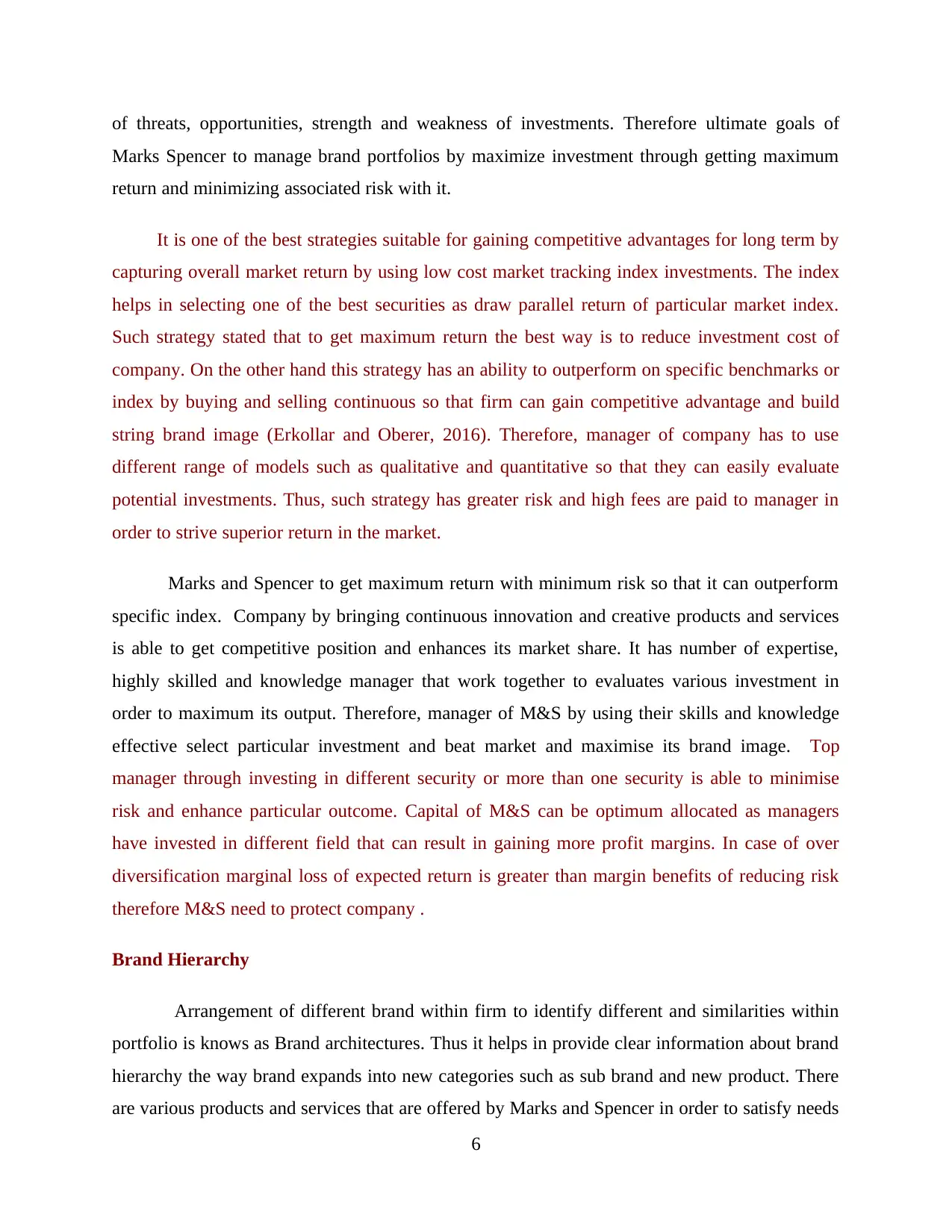
of threats, opportunities, strength and weakness of investments. Therefore ultimate goals of
Marks Spencer to manage brand portfolios by maximize investment through getting maximum
return and minimizing associated risk with it.
It is one of the best strategies suitable for gaining competitive advantages for long term by
capturing overall market return by using low cost market tracking index investments. The index
helps in selecting one of the best securities as draw parallel return of particular market index.
Such strategy stated that to get maximum return the best way is to reduce investment cost of
company. On the other hand this strategy has an ability to outperform on specific benchmarks or
index by buying and selling continuous so that firm can gain competitive advantage and build
string brand image (Erkollar and Oberer, 2016). Therefore, manager of company has to use
different range of models such as qualitative and quantitative so that they can easily evaluate
potential investments. Thus, such strategy has greater risk and high fees are paid to manager in
order to strive superior return in the market.
Marks and Spencer to get maximum return with minimum risk so that it can outperform
specific index. Company by bringing continuous innovation and creative products and services
is able to get competitive position and enhances its market share. It has number of expertise,
highly skilled and knowledge manager that work together to evaluates various investment in
order to maximum its output. Therefore, manager of M&S by using their skills and knowledge
effective select particular investment and beat market and maximise its brand image. Top
manager through investing in different security or more than one security is able to minimise
risk and enhance particular outcome. Capital of M&S can be optimum allocated as managers
have invested in different field that can result in gaining more profit margins. In case of over
diversification marginal loss of expected return is greater than margin benefits of reducing risk
therefore M&S need to protect company .
Brand Hierarchy
Arrangement of different brand within firm to identify different and similarities within
portfolio is knows as Brand architectures. Thus it helps in provide clear information about brand
hierarchy the way brand expands into new categories such as sub brand and new product. There
are various products and services that are offered by Marks and Spencer in order to satisfy needs
6
Marks Spencer to manage brand portfolios by maximize investment through getting maximum
return and minimizing associated risk with it.
It is one of the best strategies suitable for gaining competitive advantages for long term by
capturing overall market return by using low cost market tracking index investments. The index
helps in selecting one of the best securities as draw parallel return of particular market index.
Such strategy stated that to get maximum return the best way is to reduce investment cost of
company. On the other hand this strategy has an ability to outperform on specific benchmarks or
index by buying and selling continuous so that firm can gain competitive advantage and build
string brand image (Erkollar and Oberer, 2016). Therefore, manager of company has to use
different range of models such as qualitative and quantitative so that they can easily evaluate
potential investments. Thus, such strategy has greater risk and high fees are paid to manager in
order to strive superior return in the market.
Marks and Spencer to get maximum return with minimum risk so that it can outperform
specific index. Company by bringing continuous innovation and creative products and services
is able to get competitive position and enhances its market share. It has number of expertise,
highly skilled and knowledge manager that work together to evaluates various investment in
order to maximum its output. Therefore, manager of M&S by using their skills and knowledge
effective select particular investment and beat market and maximise its brand image. Top
manager through investing in different security or more than one security is able to minimise
risk and enhance particular outcome. Capital of M&S can be optimum allocated as managers
have invested in different field that can result in gaining more profit margins. In case of over
diversification marginal loss of expected return is greater than margin benefits of reducing risk
therefore M&S need to protect company .
Brand Hierarchy
Arrangement of different brand within firm to identify different and similarities within
portfolio is knows as Brand architectures. Thus it helps in provide clear information about brand
hierarchy the way brand expands into new categories such as sub brand and new product. There
are various products and services that are offered by Marks and Spencer in order to satisfy needs
6
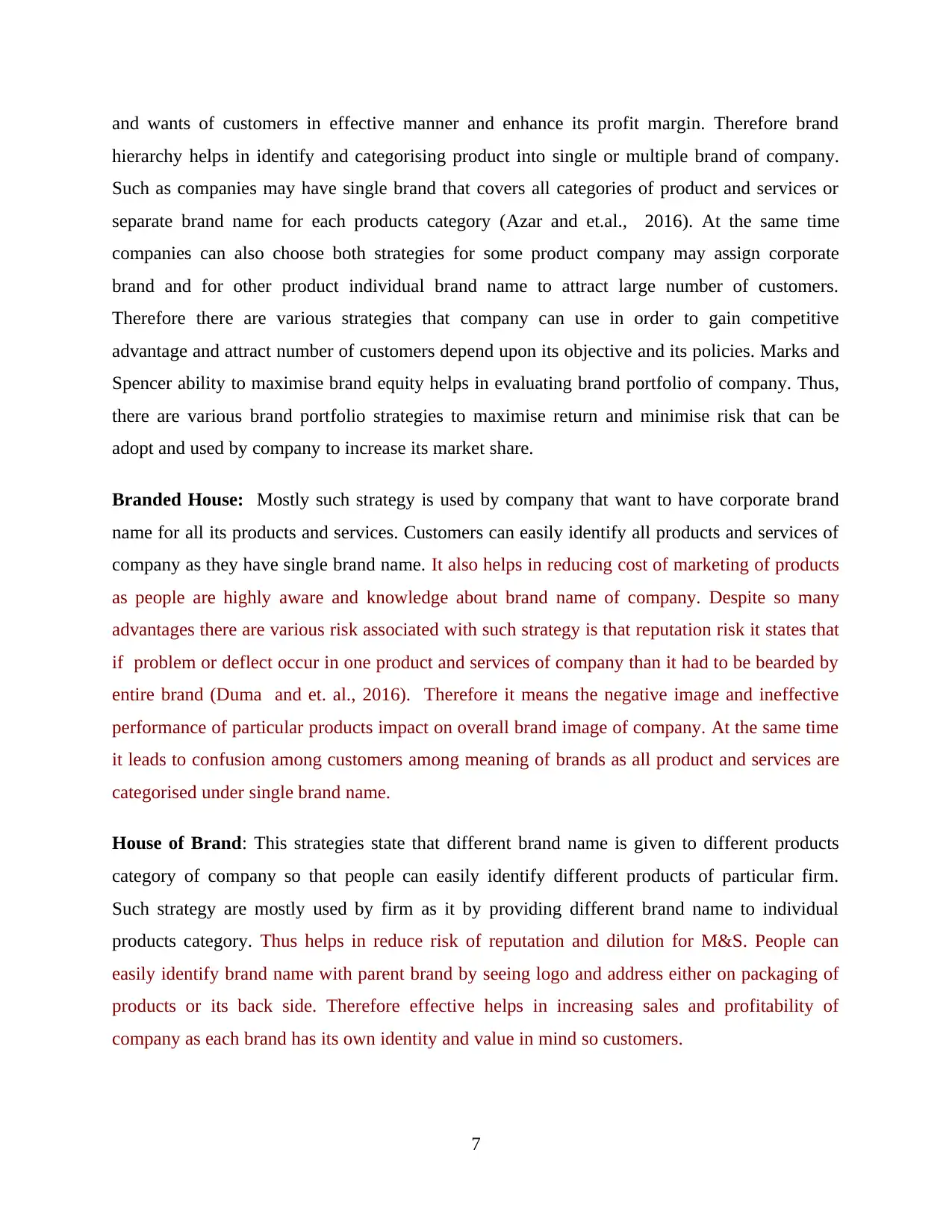
and wants of customers in effective manner and enhance its profit margin. Therefore brand
hierarchy helps in identify and categorising product into single or multiple brand of company.
Such as companies may have single brand that covers all categories of product and services or
separate brand name for each products category (Azar and et.al., 2016). At the same time
companies can also choose both strategies for some product company may assign corporate
brand and for other product individual brand name to attract large number of customers.
Therefore there are various strategies that company can use in order to gain competitive
advantage and attract number of customers depend upon its objective and its policies. Marks and
Spencer ability to maximise brand equity helps in evaluating brand portfolio of company. Thus,
there are various brand portfolio strategies to maximise return and minimise risk that can be
adopt and used by company to increase its market share.
Branded House: Mostly such strategy is used by company that want to have corporate brand
name for all its products and services. Customers can easily identify all products and services of
company as they have single brand name. It also helps in reducing cost of marketing of products
as people are highly aware and knowledge about brand name of company. Despite so many
advantages there are various risk associated with such strategy is that reputation risk it states that
if problem or deflect occur in one product and services of company than it had to be bearded by
entire brand (Duma and et. al., 2016). Therefore it means the negative image and ineffective
performance of particular products impact on overall brand image of company. At the same time
it leads to confusion among customers among meaning of brands as all product and services are
categorised under single brand name.
House of Brand: This strategies state that different brand name is given to different products
category of company so that people can easily identify different products of particular firm.
Such strategy are mostly used by firm as it by providing different brand name to individual
products category. Thus helps in reduce risk of reputation and dilution for M&S. People can
easily identify brand name with parent brand by seeing logo and address either on packaging of
products or its back side. Therefore effective helps in increasing sales and profitability of
company as each brand has its own identity and value in mind so customers.
7
hierarchy helps in identify and categorising product into single or multiple brand of company.
Such as companies may have single brand that covers all categories of product and services or
separate brand name for each products category (Azar and et.al., 2016). At the same time
companies can also choose both strategies for some product company may assign corporate
brand and for other product individual brand name to attract large number of customers.
Therefore there are various strategies that company can use in order to gain competitive
advantage and attract number of customers depend upon its objective and its policies. Marks and
Spencer ability to maximise brand equity helps in evaluating brand portfolio of company. Thus,
there are various brand portfolio strategies to maximise return and minimise risk that can be
adopt and used by company to increase its market share.
Branded House: Mostly such strategy is used by company that want to have corporate brand
name for all its products and services. Customers can easily identify all products and services of
company as they have single brand name. It also helps in reducing cost of marketing of products
as people are highly aware and knowledge about brand name of company. Despite so many
advantages there are various risk associated with such strategy is that reputation risk it states that
if problem or deflect occur in one product and services of company than it had to be bearded by
entire brand (Duma and et. al., 2016). Therefore it means the negative image and ineffective
performance of particular products impact on overall brand image of company. At the same time
it leads to confusion among customers among meaning of brands as all product and services are
categorised under single brand name.
House of Brand: This strategies state that different brand name is given to different products
category of company so that people can easily identify different products of particular firm.
Such strategy are mostly used by firm as it by providing different brand name to individual
products category. Thus helps in reduce risk of reputation and dilution for M&S. People can
easily identify brand name with parent brand by seeing logo and address either on packaging of
products or its back side. Therefore effective helps in increasing sales and profitability of
company as each brand has its own identity and value in mind so customers.
7
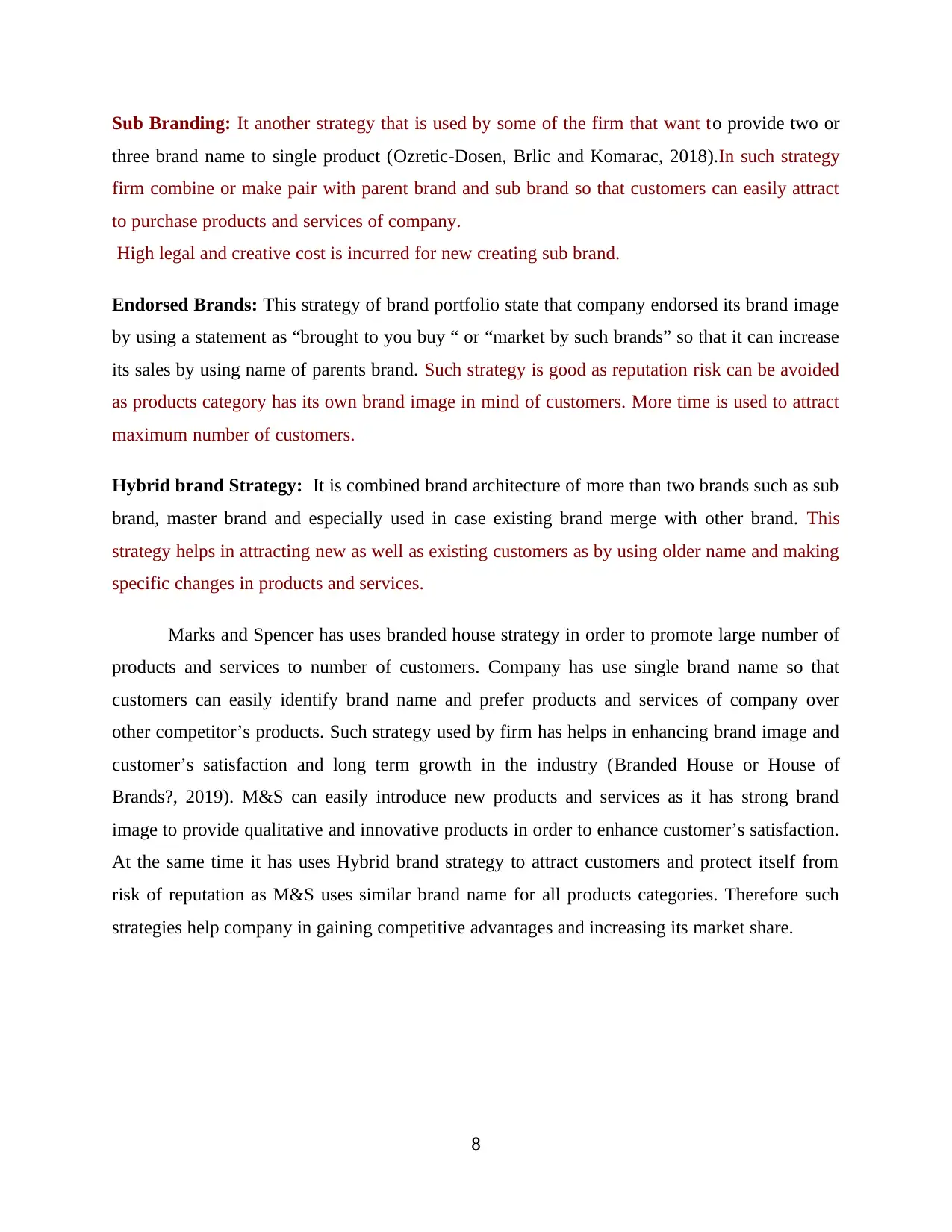
Sub Branding: It another strategy that is used by some of the firm that want to provide two or
three brand name to single product (Ozretic-Dosen, Brlic and Komarac, 2018).In such strategy
firm combine or make pair with parent brand and sub brand so that customers can easily attract
to purchase products and services of company.
High legal and creative cost is incurred for new creating sub brand.
Endorsed Brands: This strategy of brand portfolio state that company endorsed its brand image
by using a statement as “brought to you buy “ or “market by such brands” so that it can increase
its sales by using name of parents brand. Such strategy is good as reputation risk can be avoided
as products category has its own brand image in mind of customers. More time is used to attract
maximum number of customers.
Hybrid brand Strategy: It is combined brand architecture of more than two brands such as sub
brand, master brand and especially used in case existing brand merge with other brand. This
strategy helps in attracting new as well as existing customers as by using older name and making
specific changes in products and services.
Marks and Spencer has uses branded house strategy in order to promote large number of
products and services to number of customers. Company has use single brand name so that
customers can easily identify brand name and prefer products and services of company over
other competitor’s products. Such strategy used by firm has helps in enhancing brand image and
customer’s satisfaction and long term growth in the industry (Branded House or House of
Brands?, 2019). M&S can easily introduce new products and services as it has strong brand
image to provide qualitative and innovative products in order to enhance customer’s satisfaction.
At the same time it has uses Hybrid brand strategy to attract customers and protect itself from
risk of reputation as M&S uses similar brand name for all products categories. Therefore such
strategies help company in gaining competitive advantages and increasing its market share.
8
three brand name to single product (Ozretic-Dosen, Brlic and Komarac, 2018).In such strategy
firm combine or make pair with parent brand and sub brand so that customers can easily attract
to purchase products and services of company.
High legal and creative cost is incurred for new creating sub brand.
Endorsed Brands: This strategy of brand portfolio state that company endorsed its brand image
by using a statement as “brought to you buy “ or “market by such brands” so that it can increase
its sales by using name of parents brand. Such strategy is good as reputation risk can be avoided
as products category has its own brand image in mind of customers. More time is used to attract
maximum number of customers.
Hybrid brand Strategy: It is combined brand architecture of more than two brands such as sub
brand, master brand and especially used in case existing brand merge with other brand. This
strategy helps in attracting new as well as existing customers as by using older name and making
specific changes in products and services.
Marks and Spencer has uses branded house strategy in order to promote large number of
products and services to number of customers. Company has use single brand name so that
customers can easily identify brand name and prefer products and services of company over
other competitor’s products. Such strategy used by firm has helps in enhancing brand image and
customer’s satisfaction and long term growth in the industry (Branded House or House of
Brands?, 2019). M&S can easily introduce new products and services as it has strong brand
image to provide qualitative and innovative products in order to enhance customer’s satisfaction.
At the same time it has uses Hybrid brand strategy to attract customers and protect itself from
risk of reputation as M&S uses similar brand name for all products categories. Therefore such
strategies help company in gaining competitive advantages and increasing its market share.
8
Secure Best Marks with AI Grader
Need help grading? Try our AI Grader for instant feedback on your assignments.
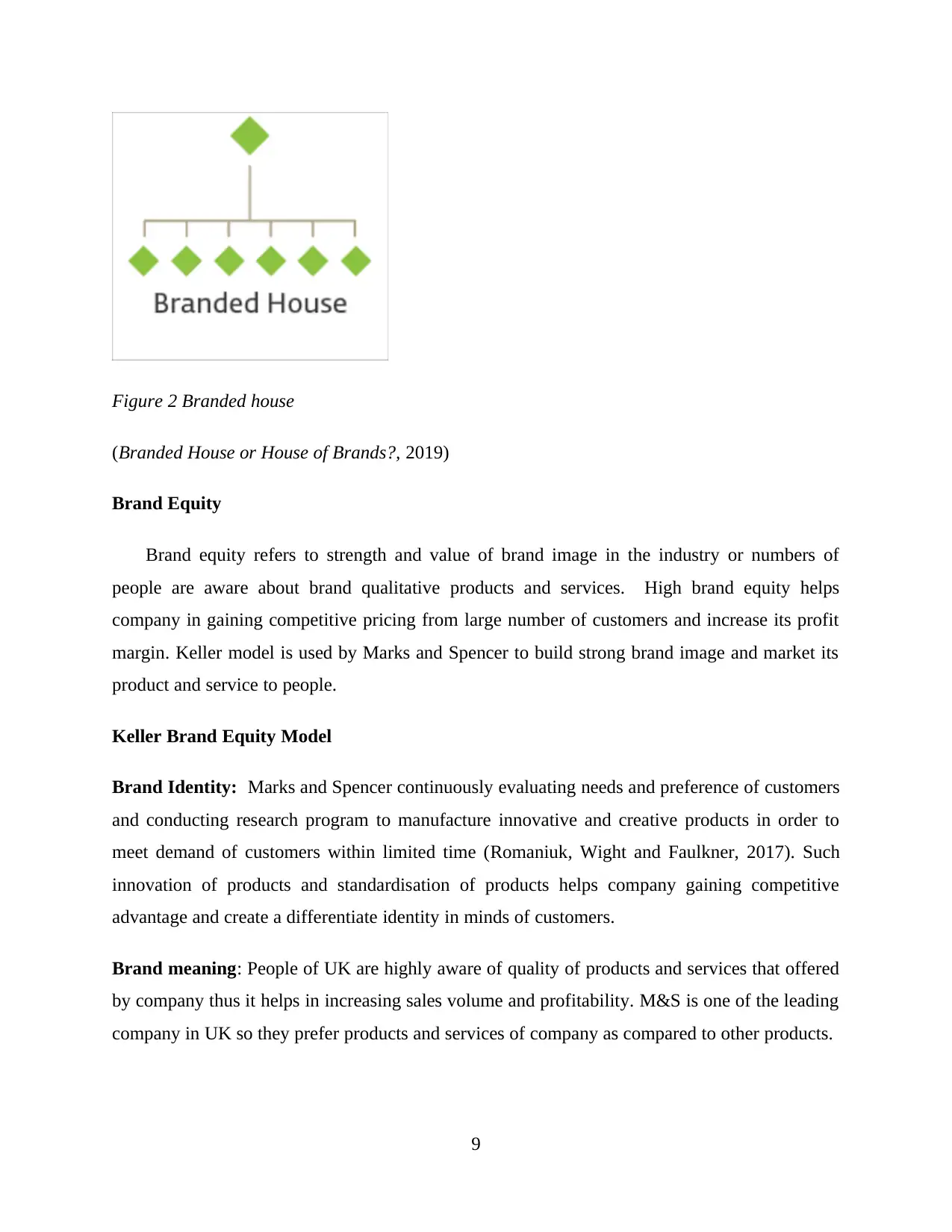
Figure 2 Branded house
(Branded House or House of Brands?, 2019)
Brand Equity
Brand equity refers to strength and value of brand image in the industry or numbers of
people are aware about brand qualitative products and services. High brand equity helps
company in gaining competitive pricing from large number of customers and increase its profit
margin. Keller model is used by Marks and Spencer to build strong brand image and market its
product and service to people.
Keller Brand Equity Model
Brand Identity: Marks and Spencer continuously evaluating needs and preference of customers
and conducting research program to manufacture innovative and creative products in order to
meet demand of customers within limited time (Romaniuk, Wight and Faulkner, 2017). Such
innovation of products and standardisation of products helps company gaining competitive
advantage and create a differentiate identity in minds of customers.
Brand meaning: People of UK are highly aware of quality of products and services that offered
by company thus it helps in increasing sales volume and profitability. M&S is one of the leading
company in UK so they prefer products and services of company as compared to other products.
9
(Branded House or House of Brands?, 2019)
Brand Equity
Brand equity refers to strength and value of brand image in the industry or numbers of
people are aware about brand qualitative products and services. High brand equity helps
company in gaining competitive pricing from large number of customers and increase its profit
margin. Keller model is used by Marks and Spencer to build strong brand image and market its
product and service to people.
Keller Brand Equity Model
Brand Identity: Marks and Spencer continuously evaluating needs and preference of customers
and conducting research program to manufacture innovative and creative products in order to
meet demand of customers within limited time (Romaniuk, Wight and Faulkner, 2017). Such
innovation of products and standardisation of products helps company gaining competitive
advantage and create a differentiate identity in minds of customers.
Brand meaning: People of UK are highly aware of quality of products and services that offered
by company thus it helps in increasing sales volume and profitability. M&S is one of the leading
company in UK so they prefer products and services of company as compared to other products.
9
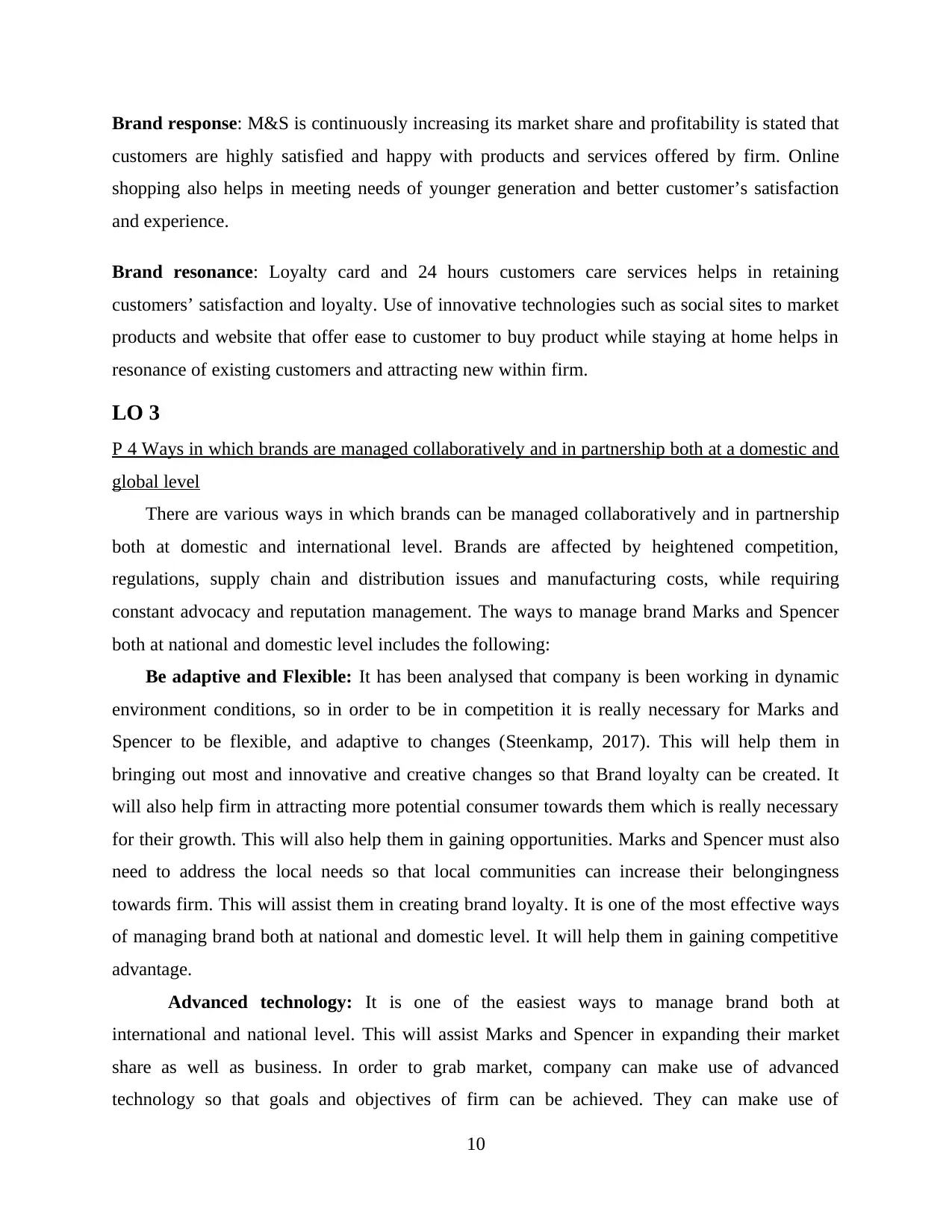
Brand response: M&S is continuously increasing its market share and profitability is stated that
customers are highly satisfied and happy with products and services offered by firm. Online
shopping also helps in meeting needs of younger generation and better customer’s satisfaction
and experience.
Brand resonance: Loyalty card and 24 hours customers care services helps in retaining
customers’ satisfaction and loyalty. Use of innovative technologies such as social sites to market
products and website that offer ease to customer to buy product while staying at home helps in
resonance of existing customers and attracting new within firm.
LO 3
P 4 Ways in which brands are managed collaboratively and in partnership both at a domestic and
global level
There are various ways in which brands can be managed collaboratively and in partnership
both at domestic and international level. Brands are affected by heightened competition,
regulations, supply chain and distribution issues and manufacturing costs, while requiring
constant advocacy and reputation management. The ways to manage brand Marks and Spencer
both at national and domestic level includes the following:
Be adaptive and Flexible: It has been analysed that company is been working in dynamic
environment conditions, so in order to be in competition it is really necessary for Marks and
Spencer to be flexible, and adaptive to changes (Steenkamp, 2017). This will help them in
bringing out most and innovative and creative changes so that Brand loyalty can be created. It
will also help firm in attracting more potential consumer towards them which is really necessary
for their growth. This will also help them in gaining opportunities. Marks and Spencer must also
need to address the local needs so that local communities can increase their belongingness
towards firm. This will assist them in creating brand loyalty. It is one of the most effective ways
of managing brand both at national and domestic level. It will help them in gaining competitive
advantage.
Advanced technology: It is one of the easiest ways to manage brand both at
international and national level. This will assist Marks and Spencer in expanding their market
share as well as business. In order to grab market, company can make use of advanced
technology so that goals and objectives of firm can be achieved. They can make use of
10
customers are highly satisfied and happy with products and services offered by firm. Online
shopping also helps in meeting needs of younger generation and better customer’s satisfaction
and experience.
Brand resonance: Loyalty card and 24 hours customers care services helps in retaining
customers’ satisfaction and loyalty. Use of innovative technologies such as social sites to market
products and website that offer ease to customer to buy product while staying at home helps in
resonance of existing customers and attracting new within firm.
LO 3
P 4 Ways in which brands are managed collaboratively and in partnership both at a domestic and
global level
There are various ways in which brands can be managed collaboratively and in partnership
both at domestic and international level. Brands are affected by heightened competition,
regulations, supply chain and distribution issues and manufacturing costs, while requiring
constant advocacy and reputation management. The ways to manage brand Marks and Spencer
both at national and domestic level includes the following:
Be adaptive and Flexible: It has been analysed that company is been working in dynamic
environment conditions, so in order to be in competition it is really necessary for Marks and
Spencer to be flexible, and adaptive to changes (Steenkamp, 2017). This will help them in
bringing out most and innovative and creative changes so that Brand loyalty can be created. It
will also help firm in attracting more potential consumer towards them which is really necessary
for their growth. This will also help them in gaining opportunities. Marks and Spencer must also
need to address the local needs so that local communities can increase their belongingness
towards firm. This will assist them in creating brand loyalty. It is one of the most effective ways
of managing brand both at national and domestic level. It will help them in gaining competitive
advantage.
Advanced technology: It is one of the easiest ways to manage brand both at
international and national level. This will assist Marks and Spencer in expanding their market
share as well as business. In order to grab market, company can make use of advanced
technology so that goals and objectives of firm can be achieved. They can make use of
10
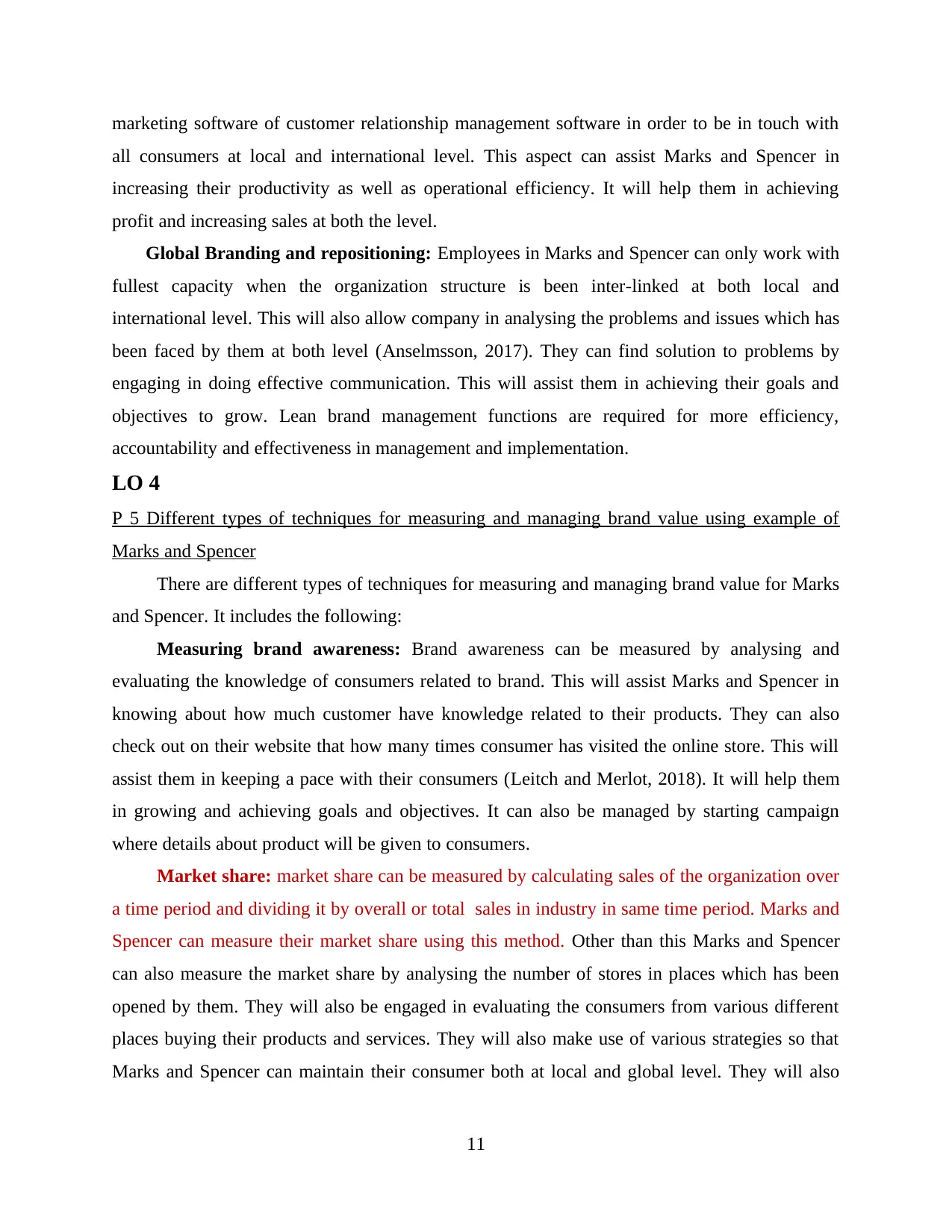
marketing software of customer relationship management software in order to be in touch with
all consumers at local and international level. This aspect can assist Marks and Spencer in
increasing their productivity as well as operational efficiency. It will help them in achieving
profit and increasing sales at both the level.
Global Branding and repositioning: Employees in Marks and Spencer can only work with
fullest capacity when the organization structure is been inter-linked at both local and
international level. This will also allow company in analysing the problems and issues which has
been faced by them at both level (Anselmsson, 2017). They can find solution to problems by
engaging in doing effective communication. This will assist them in achieving their goals and
objectives to grow. Lean brand management functions are required for more efficiency,
accountability and effectiveness in management and implementation.
LO 4
P 5 Different types of techniques for measuring and managing brand value using example of
Marks and Spencer
There are different types of techniques for measuring and managing brand value for Marks
and Spencer. It includes the following:
Measuring brand awareness: Brand awareness can be measured by analysing and
evaluating the knowledge of consumers related to brand. This will assist Marks and Spencer in
knowing about how much customer have knowledge related to their products. They can also
check out on their website that how many times consumer has visited the online store. This will
assist them in keeping a pace with their consumers (Leitch and Merlot, 2018). It will help them
in growing and achieving goals and objectives. It can also be managed by starting campaign
where details about product will be given to consumers.
Market share: market share can be measured by calculating sales of the organization over
a time period and dividing it by overall or total sales in industry in same time period. Marks and
Spencer can measure their market share using this method. Other than this Marks and Spencer
can also measure the market share by analysing the number of stores in places which has been
opened by them. They will also be engaged in evaluating the consumers from various different
places buying their products and services. They will also make use of various strategies so that
Marks and Spencer can maintain their consumer both at local and global level. They will also
11
all consumers at local and international level. This aspect can assist Marks and Spencer in
increasing their productivity as well as operational efficiency. It will help them in achieving
profit and increasing sales at both the level.
Global Branding and repositioning: Employees in Marks and Spencer can only work with
fullest capacity when the organization structure is been inter-linked at both local and
international level. This will also allow company in analysing the problems and issues which has
been faced by them at both level (Anselmsson, 2017). They can find solution to problems by
engaging in doing effective communication. This will assist them in achieving their goals and
objectives to grow. Lean brand management functions are required for more efficiency,
accountability and effectiveness in management and implementation.
LO 4
P 5 Different types of techniques for measuring and managing brand value using example of
Marks and Spencer
There are different types of techniques for measuring and managing brand value for Marks
and Spencer. It includes the following:
Measuring brand awareness: Brand awareness can be measured by analysing and
evaluating the knowledge of consumers related to brand. This will assist Marks and Spencer in
knowing about how much customer have knowledge related to their products. They can also
check out on their website that how many times consumer has visited the online store. This will
assist them in keeping a pace with their consumers (Leitch and Merlot, 2018). It will help them
in growing and achieving goals and objectives. It can also be managed by starting campaign
where details about product will be given to consumers.
Market share: market share can be measured by calculating sales of the organization over
a time period and dividing it by overall or total sales in industry in same time period. Marks and
Spencer can measure their market share using this method. Other than this Marks and Spencer
can also measure the market share by analysing the number of stores in places which has been
opened by them. They will also be engaged in evaluating the consumers from various different
places buying their products and services. They will also make use of various strategies so that
Marks and Spencer can maintain their consumer both at local and global level. They will also
11
Paraphrase This Document
Need a fresh take? Get an instant paraphrase of this document with our AI Paraphraser
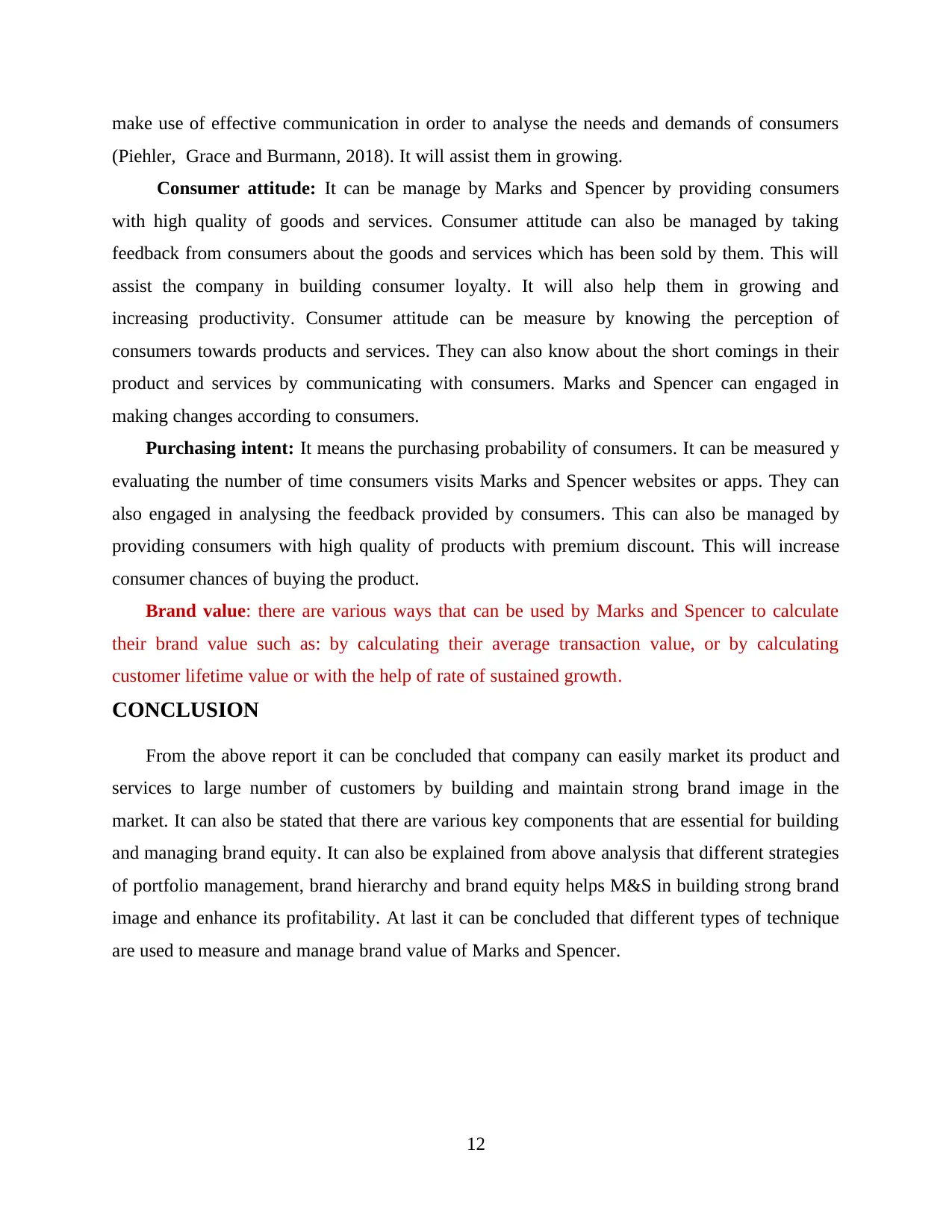
make use of effective communication in order to analyse the needs and demands of consumers
(Piehler, Grace and Burmann, 2018). It will assist them in growing.
Consumer attitude: It can be manage by Marks and Spencer by providing consumers
with high quality of goods and services. Consumer attitude can also be managed by taking
feedback from consumers about the goods and services which has been sold by them. This will
assist the company in building consumer loyalty. It will also help them in growing and
increasing productivity. Consumer attitude can be measure by knowing the perception of
consumers towards products and services. They can also know about the short comings in their
product and services by communicating with consumers. Marks and Spencer can engaged in
making changes according to consumers.
Purchasing intent: It means the purchasing probability of consumers. It can be measured y
evaluating the number of time consumers visits Marks and Spencer websites or apps. They can
also engaged in analysing the feedback provided by consumers. This can also be managed by
providing consumers with high quality of products with premium discount. This will increase
consumer chances of buying the product.
Brand value: there are various ways that can be used by Marks and Spencer to calculate
their brand value such as: by calculating their average transaction value, or by calculating
customer lifetime value or with the help of rate of sustained growth.
CONCLUSION
From the above report it can be concluded that company can easily market its product and
services to large number of customers by building and maintain strong brand image in the
market. It can also be stated that there are various key components that are essential for building
and managing brand equity. It can also be explained from above analysis that different strategies
of portfolio management, brand hierarchy and brand equity helps M&S in building strong brand
image and enhance its profitability. At last it can be concluded that different types of technique
are used to measure and manage brand value of Marks and Spencer.
12
(Piehler, Grace and Burmann, 2018). It will assist them in growing.
Consumer attitude: It can be manage by Marks and Spencer by providing consumers
with high quality of goods and services. Consumer attitude can also be managed by taking
feedback from consumers about the goods and services which has been sold by them. This will
assist the company in building consumer loyalty. It will also help them in growing and
increasing productivity. Consumer attitude can be measure by knowing the perception of
consumers towards products and services. They can also know about the short comings in their
product and services by communicating with consumers. Marks and Spencer can engaged in
making changes according to consumers.
Purchasing intent: It means the purchasing probability of consumers. It can be measured y
evaluating the number of time consumers visits Marks and Spencer websites or apps. They can
also engaged in analysing the feedback provided by consumers. This can also be managed by
providing consumers with high quality of products with premium discount. This will increase
consumer chances of buying the product.
Brand value: there are various ways that can be used by Marks and Spencer to calculate
their brand value such as: by calculating their average transaction value, or by calculating
customer lifetime value or with the help of rate of sustained growth.
CONCLUSION
From the above report it can be concluded that company can easily market its product and
services to large number of customers by building and maintain strong brand image in the
market. It can also be stated that there are various key components that are essential for building
and managing brand equity. It can also be explained from above analysis that different strategies
of portfolio management, brand hierarchy and brand equity helps M&S in building strong brand
image and enhance its profitability. At last it can be concluded that different types of technique
are used to measure and manage brand value of Marks and Spencer.
12
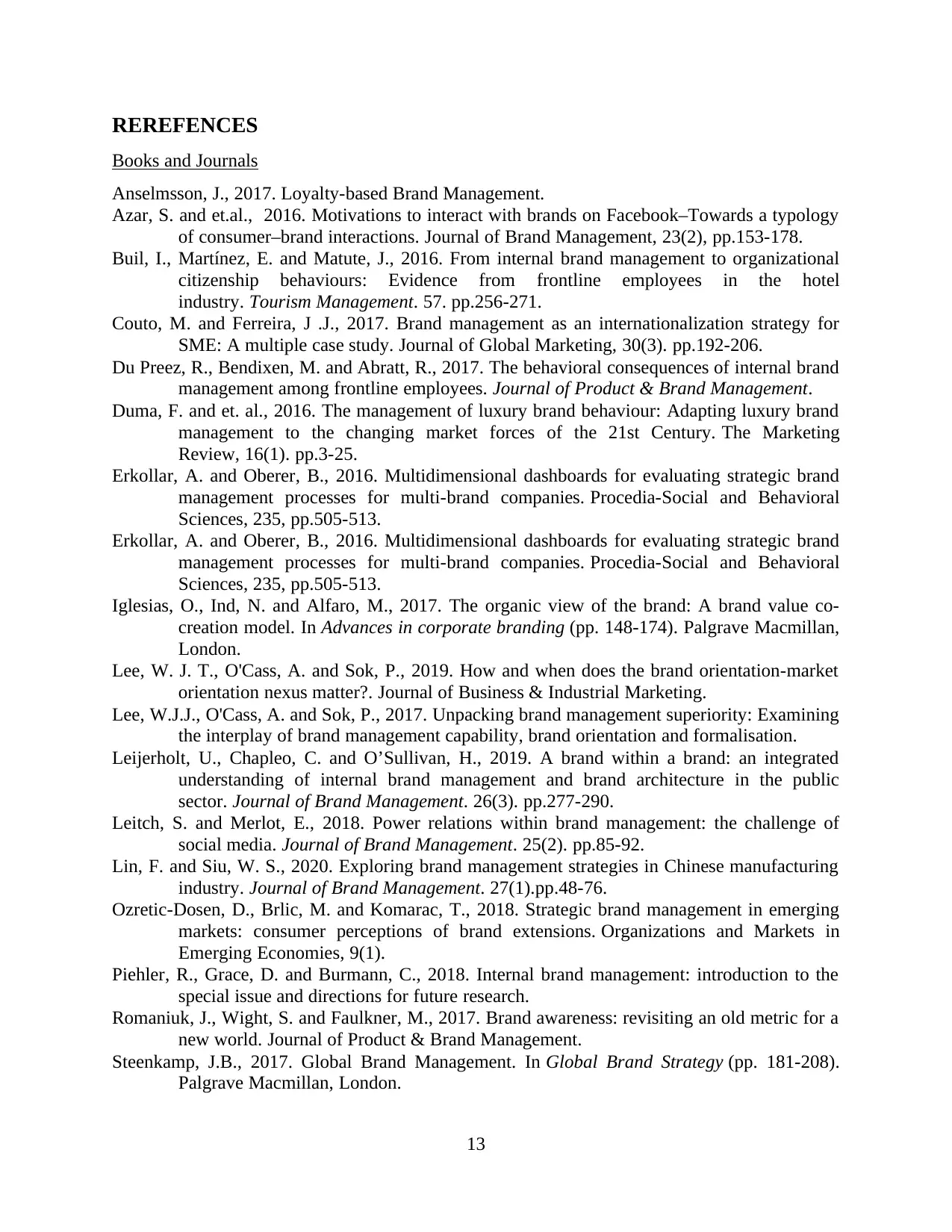
REREFENCES
Books and Journals
Anselmsson, J., 2017. Loyalty-based Brand Management.
Azar, S. and et.al., 2016. Motivations to interact with brands on Facebook–Towards a typology
of consumer–brand interactions. Journal of Brand Management, 23(2), pp.153-178.
Buil, I., Martínez, E. and Matute, J., 2016. From internal brand management to organizational
citizenship behaviours: Evidence from frontline employees in the hotel
industry. Tourism Management. 57. pp.256-271.
Couto, M. and Ferreira, J .J., 2017. Brand management as an internationalization strategy for
SME: A multiple case study. Journal of Global Marketing, 30(3). pp.192-206.
Du Preez, R., Bendixen, M. and Abratt, R., 2017. The behavioral consequences of internal brand
management among frontline employees. Journal of Product & Brand Management.
Duma, F. and et. al., 2016. The management of luxury brand behaviour: Adapting luxury brand
management to the changing market forces of the 21st Century. The Marketing
Review, 16(1). pp.3-25.
Erkollar, A. and Oberer, B., 2016. Multidimensional dashboards for evaluating strategic brand
management processes for multi-brand companies. Procedia-Social and Behavioral
Sciences, 235, pp.505-513.
Erkollar, A. and Oberer, B., 2016. Multidimensional dashboards for evaluating strategic brand
management processes for multi-brand companies. Procedia-Social and Behavioral
Sciences, 235, pp.505-513.
Iglesias, O., Ind, N. and Alfaro, M., 2017. The organic view of the brand: A brand value co-
creation model. In Advances in corporate branding (pp. 148-174). Palgrave Macmillan,
London.
Lee, W. J. T., O'Cass, A. and Sok, P., 2019. How and when does the brand orientation-market
orientation nexus matter?. Journal of Business & Industrial Marketing.
Lee, W.J.J., O'Cass, A. and Sok, P., 2017. Unpacking brand management superiority: Examining
the interplay of brand management capability, brand orientation and formalisation.
Leijerholt, U., Chapleo, C. and O’Sullivan, H., 2019. A brand within a brand: an integrated
understanding of internal brand management and brand architecture in the public
sector. Journal of Brand Management. 26(3). pp.277-290.
Leitch, S. and Merlot, E., 2018. Power relations within brand management: the challenge of
social media. Journal of Brand Management. 25(2). pp.85-92.
Lin, F. and Siu, W. S., 2020. Exploring brand management strategies in Chinese manufacturing
industry. Journal of Brand Management. 27(1).pp.48-76.
Ozretic-Dosen, D., Brlic, M. and Komarac, T., 2018. Strategic brand management in emerging
markets: consumer perceptions of brand extensions. Organizations and Markets in
Emerging Economies, 9(1).
Piehler, R., Grace, D. and Burmann, C., 2018. Internal brand management: introduction to the
special issue and directions for future research.
Romaniuk, J., Wight, S. and Faulkner, M., 2017. Brand awareness: revisiting an old metric for a
new world. Journal of Product & Brand Management.
Steenkamp, J.B., 2017. Global Brand Management. In Global Brand Strategy (pp. 181-208).
Palgrave Macmillan, London.
13
Books and Journals
Anselmsson, J., 2017. Loyalty-based Brand Management.
Azar, S. and et.al., 2016. Motivations to interact with brands on Facebook–Towards a typology
of consumer–brand interactions. Journal of Brand Management, 23(2), pp.153-178.
Buil, I., Martínez, E. and Matute, J., 2016. From internal brand management to organizational
citizenship behaviours: Evidence from frontline employees in the hotel
industry. Tourism Management. 57. pp.256-271.
Couto, M. and Ferreira, J .J., 2017. Brand management as an internationalization strategy for
SME: A multiple case study. Journal of Global Marketing, 30(3). pp.192-206.
Du Preez, R., Bendixen, M. and Abratt, R., 2017. The behavioral consequences of internal brand
management among frontline employees. Journal of Product & Brand Management.
Duma, F. and et. al., 2016. The management of luxury brand behaviour: Adapting luxury brand
management to the changing market forces of the 21st Century. The Marketing
Review, 16(1). pp.3-25.
Erkollar, A. and Oberer, B., 2016. Multidimensional dashboards for evaluating strategic brand
management processes for multi-brand companies. Procedia-Social and Behavioral
Sciences, 235, pp.505-513.
Erkollar, A. and Oberer, B., 2016. Multidimensional dashboards for evaluating strategic brand
management processes for multi-brand companies. Procedia-Social and Behavioral
Sciences, 235, pp.505-513.
Iglesias, O., Ind, N. and Alfaro, M., 2017. The organic view of the brand: A brand value co-
creation model. In Advances in corporate branding (pp. 148-174). Palgrave Macmillan,
London.
Lee, W. J. T., O'Cass, A. and Sok, P., 2019. How and when does the brand orientation-market
orientation nexus matter?. Journal of Business & Industrial Marketing.
Lee, W.J.J., O'Cass, A. and Sok, P., 2017. Unpacking brand management superiority: Examining
the interplay of brand management capability, brand orientation and formalisation.
Leijerholt, U., Chapleo, C. and O’Sullivan, H., 2019. A brand within a brand: an integrated
understanding of internal brand management and brand architecture in the public
sector. Journal of Brand Management. 26(3). pp.277-290.
Leitch, S. and Merlot, E., 2018. Power relations within brand management: the challenge of
social media. Journal of Brand Management. 25(2). pp.85-92.
Lin, F. and Siu, W. S., 2020. Exploring brand management strategies in Chinese manufacturing
industry. Journal of Brand Management. 27(1).pp.48-76.
Ozretic-Dosen, D., Brlic, M. and Komarac, T., 2018. Strategic brand management in emerging
markets: consumer perceptions of brand extensions. Organizations and Markets in
Emerging Economies, 9(1).
Piehler, R., Grace, D. and Burmann, C., 2018. Internal brand management: introduction to the
special issue and directions for future research.
Romaniuk, J., Wight, S. and Faulkner, M., 2017. Brand awareness: revisiting an old metric for a
new world. Journal of Product & Brand Management.
Steenkamp, J.B., 2017. Global Brand Management. In Global Brand Strategy (pp. 181-208).
Palgrave Macmillan, London.
13
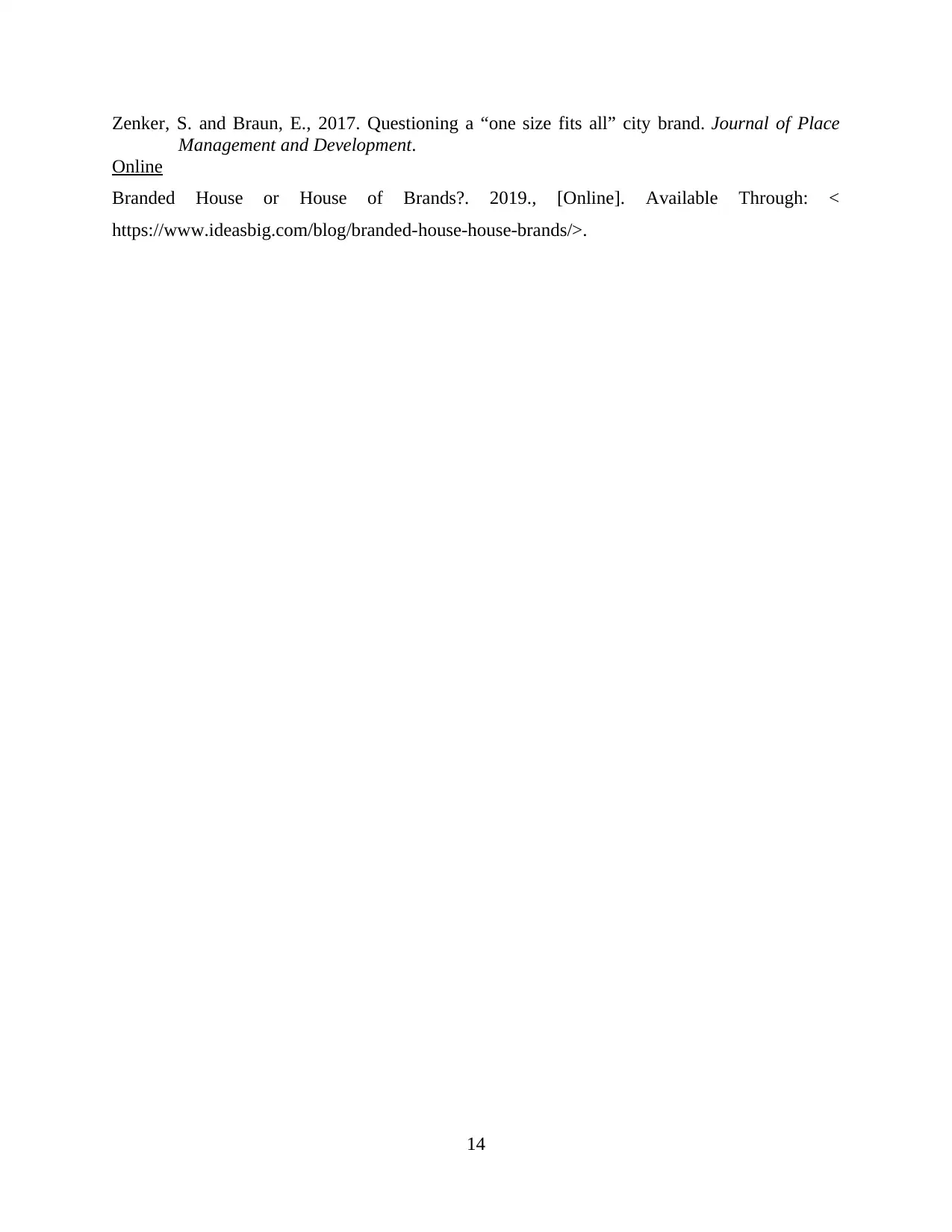
Zenker, S. and Braun, E., 2017. Questioning a “one size fits all” city brand. Journal of Place
Management and Development.
Online
Branded House or House of Brands?. 2019., [Online]. Available Through: <
https://www.ideasbig.com/blog/branded-house-house-brands/>.
14
Management and Development.
Online
Branded House or House of Brands?. 2019., [Online]. Available Through: <
https://www.ideasbig.com/blog/branded-house-house-brands/>.
14
1 out of 16
Related Documents
Your All-in-One AI-Powered Toolkit for Academic Success.
+13062052269
info@desklib.com
Available 24*7 on WhatsApp / Email
![[object Object]](/_next/static/media/star-bottom.7253800d.svg)
Unlock your academic potential
© 2024 | Zucol Services PVT LTD | All rights reserved.





